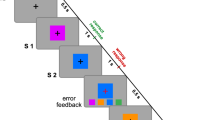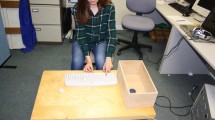Abstract
In the domain of motor learning it has been difficult to separate the neural substrate of encoding from that of change in performance. Consequently, it has not been clear whether motor effector areas participate in learning or merely modulate changes in performance. Here, using a variant of the serial reaction time task that dissociated these two factors, we report that encoding during procedural motor learning does engage cortical motor areas and can be characterized by distinct early and late encoding phases. The highest correlation between activation and subsequent changes in motor performance was seen in the motor cortex during early encoding, and in the basal ganglia during the late encoding phase. Our results show that rapid encoding during procedural motor learning involves several distinct processes, and is represented primarily within motor system structures.




Similar content being viewed by others
References
Aguirre GK, D’Esposito M (1997) Environmental knowledge is subserved by separable dorsal/ventral neural areas. J Neurosci 17:2512–2518
Berns GS, Cohen JD, Mintun MA (1997) Brain regions responsive to novelty in the absence of awareness. Science 276:1272–1275
Berridge KC, Whishaw IQ (1992). Cortex, striatum and cerebellum: control of serial order in a grooming sequence. Exp Brain Res 90:275–290
Bischoff-Grethe A, Proper SM, Mao H, Daniels KA, Berns GS (2000) Conscious and unconscious processing of nonverbal predictability in Wernicke’s area. J Neurosci 20:1975–1981
Botvinick M, Nystrom LE, Fissell K, Carter CS, Cohen JD (1999) Conflict monitoring versus selection-for-action in anterior cingulate cortex. Nature 402:179–181
Cleeremans A (1993) Mechanisms of implicit learning. MIT Press, Cambridge
Clegg BA, DiGirolamo GJ, Keele SW (1998) Sequence learning. Trends Cogn Sci 2:275–281
Cohen JD, Botvinick M, Carter CS (2000) Anterior cingulate and prefrontal cortex: who’s in control? Nat Neurosci 3:421–423
Curran T, Keele S (1993) Attentional and nonattentional forms of sequence learning. J Exp Psychol Learn Mem Cog 19:189–202
Deiber MP, Honda M, Ibanez V, Sadato N, Hallett M (1999) Mesial motor areas in self-initiated versus externally triggered movements examined with fMRI: effect of movement type and rate. J Neurophysiol 81:3065–3077
Destrebecqz A, Peigneux P, Laureys S, Degueldre C, Del Fiore G, Aerts J, Luxen A, van der Linden M, Cleeremans A, Maquet P (2003) Cerebral correlates of explicit sequence learning. Brain Res Cogn Brain Res 16:391–398
Doyon J, Owen AM, Petrides M, Sziklas V, Evans AC (1996) Functional anatomy of visuomotor skill learning in human subjects examined with positron emission tomography. Eur J Neurosci 8:637–648
Eliassen JC, Souza T, Sanes JN (2001) Human brain activation accompanying explicitly directed movement sequence learning. Exp Brain Res 141:269–80
Evans AC, Kamber M, Collins DL, Macdonald D (1994) An MRI-based probabilistic atlas of neuroanatomy. In: Shorvon S, Fish D, Andermann F, Bydder GM, Stefan H (eds) Magnetic resonance scanning and epilepsy. NATO ASI Series A, Life Sci 264. Plenum, New York, pp 263–274
Frensch PA, Lin J, Buchner A (1998) Learning versus behavioral expression of the learned: the effects of a secondary tone-counting task on implicit learning in the serial reaction time task. Psychol Res 61:83–98
Frensch PA, Wenke D, Rünger D (1999) A secondary tone-counting task suppresses expression of knowledge in the serial reaction task. J Exp Psych Learn Mem Cogn 25:260–274
Friston KJ, Holmes AP, Worsley KJ, Poline JB, Frith CD, Frackowiak RSJ (1995) Statistical parametric maps in functional imaging: a general linear approach. Hum Brain Map 2:189–210
Georgopoulos AP (2000) Neural aspects of cognitive motor control. Curr Opin Neurobio 10:238–241
Goldberg TE, Berman KF, Randolph C, Gold JM, Weinberger DR (1996) Isolating the mnemonic component in spatial delayed response: a controlled PET 15O-labeled water regional cerebral blood flow study in normal humans. Neuroimage 3:69–78
Grafton ST, Hazeltine E, Ivry RB (1995) Functional mapping of sequence learning in normal humans. J Cogn Neurosci 7:497–510
Grafton ST, Hazeltine E, Ivry RB (1998) Abstract and effector-specific representations of motor sequences identified with PET. J Neurosci 18:9420–9428
Hazeltine E, Grafton ST, Ivry RB (1997) Attention and stimulus characteristics determine the locus of motor-sequence encoding: a PET study. Brain 120:123–140
Heyes CM, Foster CL (2002) Motor learning by observation: evidence from a serial reaction time task. Q J Exp Psych 55A:593–607
Hikosaka O, Nakahara H, Rand MK, Sakai K, Lu X, Nakamura K, Miyachi S, Doya K (1999) Parallel neural networks for learning sequential procedures. Trends Neurosci 22:464–471
Honda M, Deiber M-P, Ibanez V, Pascual-Leone A, Zhuang P, Hallett M (1998) Dynamic cortical involvement in implicit and explicit motor sequence learning: a PET study. Brain 121:2159–2173
Hsiao AT, Reber AS (2001). The dual-task SRT procedure: fine-tuning the timing. Psych Bull Rev 8:336–342
Huettel SA, Mack PB, McCarthy G (2002) Perceiving patterns in random series: dynamic processing of sequence in prefrontal cortex. Nat Neurosci 5:485–490
Jancke L, Specht K, Mirzazade S, Loose R, Himmelbach M, Lutz K, Shah NJ (1998) A parametric analysis of the ‘rate effect’ in the sensorimotor cortex: a functional magnetic resonance imaging analysis in human subjects. Neurosci Lett 252:37–40
Jenkins IH, Brooks DJ, Nixon PD, Frackowiak RS, Passingham RE (1994) Motor sequence learning: a study with positron emission tomography. J Neurosci 14:3775–3790
Jimenez L, Mendez C (1999) Which attention is needed for implicit sequence learning? J Exp Psych Learn Mem Cogn 25:236–259
Jonides J, Smith EE, Koeppe RA, Awh E, Minoshima S, Mintun MA (1993) Spatial working memory in humans as revealed by PET. Nature 363:623–625
Karni A, Meyer G, Rey-Hipolito C, Jezzard P, Adams MM, Turner R, Ungerleider LG (1998) The acquisition of skilled motor performance: fast and slow experience-driven changes in primary motor cortex. Proc Natl Acad Sci USA 95:861–868
Kermadi I, Jurquet Y (1993) Neural activity in the caudate nucleus of monkeys during spatial sequencing. Exp Brain Res 94:352–6
Kitazawa S, Kimura T, Yin P-B (1998) Cerebellar complex spikes encode both destinations and errors in arm movements. Nature 392:494–497
Lacquaniti F, Perani D, Guigon E, Bettinardi V, Carrozzo M, Grassi F, Rossetti Y, Fazio F (1997) Visuomotor transformations for reaching to memorized targets: a PET study. Neuroimage 5:129–46
Lafleur MF, Jackson PL, Malouin F, Richards CL, Evans AC, Doyon J (2002) Motor learning produces parallel dynamic functional changes during the execution and imagination of sequential foot movements. Neuroimage 16:142–57
Levy R, Goldman-Rakic PS (1999) Association of storage and processing functions in the dorsolateral prefrontal cortex of the nonhuman primate. J Neurosci 19:5149–5158
Malach R, Reppas JB, Benson RR, Kwong KK, Jiang H, Kennedy WA, Ledden PJ, Brady TJ, Rosen BR, Tootell RBH (1995) Object-related activity revealed by functional magnetic resonance imaging in human occipital cortex. Proc Natl Acad Sci USA 92:8135–8139
Mattay VS, Weinberger DR (1999) Organization of the human motor system as studied by functional magnetic resonance imaging. Eur J Radiol 30:105–114
Mayr U (1996) Spatial attention and implicit sequence learning: evidence for independent learning of spatial and nonspatial sequences. J Exp Psych Learn Mem Cogn 22:350–364
Muellbacher W, Ziemann U, Wissel J, Dang N, Kofler M, Facchini S, Boroojerdi B, Poewe W, Hallett M (2002) Early consolidation in human primary motor cortex. Nature 415:640–644
Nichols TE, Holmes AP (2002) Nonparametric permutation tests for functional neuroimaging: a primer with examples. Hum Brain Map 15:1–25
Nissen MJ, Bullemer P (1987) Attentional requirements of learning: Evidence from performance measures. Cogn Psych 19:1–32
Owen AM, Evans AC, Petrides M (1996c) Evidence for a two-stage model of spatial working memory processing within the lateral frontal cortex: a positron emission tomography study. Cereb Cortex 6:31–38
Owen AM, Milner B, Petrides M, Evans AC (1996a) Memory for object features versus memory for object location: a positron-emission tomography study of encoding and retrieval processes. Proc Natl Acad Sci USA 93:9212–9217
Owen AM, Morris RG, Sahakian BJ, Polkey CE, Robbins TW (1996b) Double dissociations of memory and executive functions in working memory tasks following frontal lobe excisions, temporal lobe excisions or amygdalo-hippocampectomy in man. Brain 119:1597–1615
Owen AM, Stern CE, Look RB, Tracey I, Rosen BR, Petrides M (1998) Functional organization of spatial and nonspatial working memory processing within the human lateral frontal cortex. Proc Natl Acad Sci USA 95:7721–7726
Pascual-Leone A, Grafman J, Hallett M (1994) Modulation of cortical motor output maps during development of implicit and explicit knowledge. Science 263:1287–1289
Picard N, Strick PL (1996) Motor areas of the medial wall: a review of their location and functional activation. Cereb Cortex 6:342–353
Rauch SL, Whalen PJ, Savage CR, Curran T, Kendrick A, Brown HD, Bush G, Breiter HC, Rosen BR (1997) Striatal recruitment during an implicit sequence learning task as measured by functional magnetic resonance imaging. Hum Brain Map 5:124–132
Reber AS (1993) Implicit learning and tacit knowledge: an essay on the cognitive unconsciousness. Oxford University Press, New York
Remillard G (2003) Pure perceptual-based sequence learning. J Exp Psyc Learn Mem Cogn 29:581–597
Robertson EM, Tormos JM, Maeda F, Pascual-Leone A (2001) The role of the dorsolateral prefrontal cortex during sequence learning is specific for spatial information. Cereb Cortex 11:628–635
Sakai K, Hikosaka O, Miyauchi S, Takino R, Sasaki Y, Putz B (1998) Transition of brain activation from frontal to parietal areas in visuomotor sequence learning. J Neurosci 18:1827–1840
Seidler RD, Purushotham A, Kim S-G, Ugurbil K, Willingham D, Ashe J (2002) Cerebellum activation associated with performance change but not motor learning. Science 296:2043–2046
Shanks DR, Channon S (2002) Effects of a secondary task on “implicit” sequence learning: learning or performance? Psychol Res 66:99–109
Talairach J, Tournoux P (1988) Co-planar stereotaxic atlas of the human brain. 3-dimensional proportional system: an approach to cerebral imaging (translated by Mark Rayport). Thieme, New York
Tanji J (2001) Sequential organization of multiple movements: involvement of cortical motor areas. Annu Rev Neurosci 24:631–651
Toni I, Krams M, Turner R, Passingham RE (1998) The time course of changes during motor sequence learning: a whole-brain fMRI study. Neuroimage 8:50–61
Turner RS, Grafton ST, Votaw JR, Delong MR, Hoffman JM (1998) Motor subcircuits mediating the control of movement velocity: a PET study. J Neurophysiol 80:2162–2176
Vaughan T, Garwood M, Adriany G, Ugurbil K (2001) Volume coils for highest field MRI. In: IEEE Antennas and Propagation Society International Symposium, pp 378–381
van Veen V, Cohen JD, Botvinick MM, Stenger VA, Carter CS (2001) Anterior cingulate cortex, conflict monitoring, and levels of processing. Neuroimage 14:1302–1308
Wheeler ME, Petersen SE, Buckner RL (2000) Memory’s echo: vivid remembering reactivates sensory-specific cortex. Proc Natl Acad Sci USA 97:11125–11129
Willingham DB (1999) Implicit motor sequence learning is not purely perceptual. Mem Cognit 27:561–572
Willingham DB, Greenberg AR, Thomas RC (1997) Response-to-stimulus interval does not affect implicit motor sequence learning, but does affect performance. Mem Cogn 25:534–542
Willingham DB, Wells LA, Farrell JM, Stemwedel ME (2000) Implicit motor sequence learning is represented in response locations. Mem Cogn 28:366–375
Willingham DB, Salidis J, Gabrieli JDE (2002) Direct comparison of neural systems mediating conscious and unconscious skill learning. J Neurophysiol 88:1–10
Acknowledgements
Supported by NIH grants NS40106, MH065598, and RR08079, the Department of Veterans Affairs, and the American Legion Chair in Brain Sciences.
Author information
Authors and Affiliations
Corresponding author
Rights and permissions
About this article
Cite this article
Seidler, R.D., Purushotham, A., Kim, SG. et al. Neural correlates of encoding and expression in implicit sequence learning. Exp Brain Res 165, 114–124 (2005). https://doi.org/10.1007/s00221-005-2284-z
Received:
Accepted:
Published:
Issue Date:
DOI: https://doi.org/10.1007/s00221-005-2284-z




